Rice and beans are staple foods in many cultures, but it’s important to understand their nutritional value, especially when it comes to carbohydrates. White rice, commonly served with beans, is made up of fast-digesting carbohydrates that can lead to spikes in blood glucose levels. However, when paired with beans, it helps metabolize the carbs better. Beans, on the other hand, are complex starches that are high in fiber and protein, packed with antioxidants, and contain essential nutrients. Combining beans with rice can help prevent unhealthy blood sugar spikes and may be particularly beneficial for people with type 2 diabetes.
Additionally, beans and rice can provide a complete protein when eaten together, but a variety of foods throughout the day can achieve the same result. It’s important to be culturally sensitive and consider traditional foods like beans in dietary recommendations for different populations. The glycemic index can be a helpful tool for choosing carbohydrates that have a lower impact on blood sugar levels and promote long-term health. It is recommended to opt for minimally processed whole grain products, brown rice, whole wheat bread, and beans with a low glycemic index. Limiting the intake of potatoes and paying attention to portion sizes are also important factors in maintaining a healthy diet.
- Understanding the carbohydrate content of rice and beans is essential for managing blood sugar levels.
- Combining beans with rice can help prevent spikes in blood glucose and provide a complete protein source.
- Beans are packed with fiber, protein, antioxidants, and essential nutrients.
- Consider cultural sensitivities and traditional foods when making dietary recommendations.
- Choosing carbohydrates with a low glycemic index can promote long-term health and stable blood sugar levels.
The Carb Content of Rice and Beans
Understanding the carb content of rice and beans is crucial for anyone looking to manage their carbohydrate intake. Rice, especially white rice, is composed of fast-digesting carbohydrates that can cause blood sugar spikes. However, when combined with beans, rice’s impact on blood glucose levels can be mitigated. Beans, on the other hand, are complex starches that are rich in fiber, protein, antioxidants, and essential nutrients.
When rice and beans are consumed together, the fiber and protein from the beans help slow down the digestion and absorption of carbohydrates from the rice. This means that the carbs in the meal are released into the bloodstream more gradually, preventing sudden spikes in blood sugar levels. This can be particularly beneficial for individuals with type 2 diabetes who need to regulate their blood sugar.
It’s worth noting that when rice and beans are consumed together, they provide a complete protein. However, it’s important to have a variety of foods throughout the day to meet your nutritional needs. Being culturally sensitive is also essential when considering rice and beans in dietary recommendations, as they hold significance in many traditional cuisines.
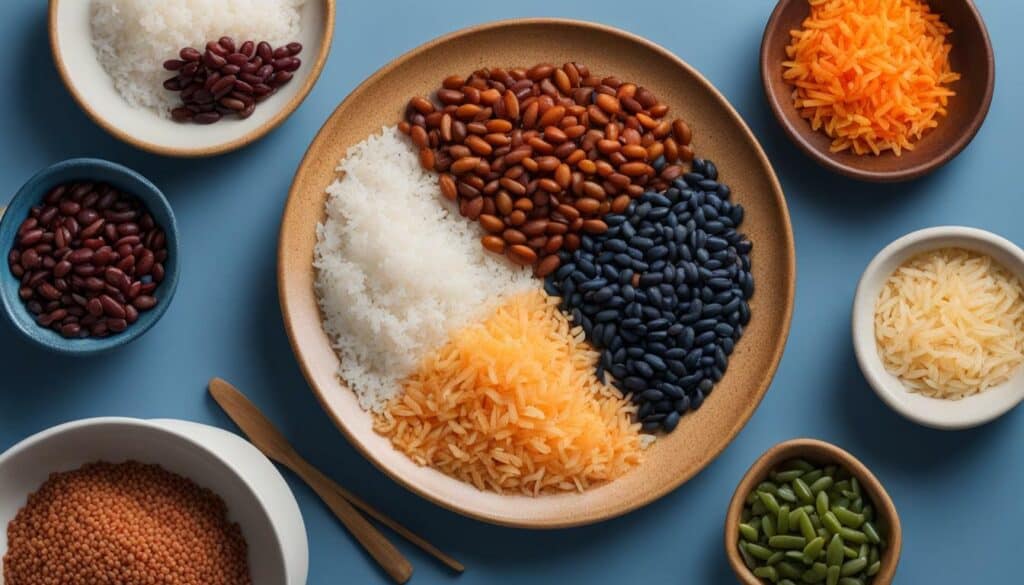
When incorporating rice and beans into your diet, it’s recommended to choose beans with a low glycemic index and opt for minimally processed whole grain products, such as brown rice and whole wheat bread. These choices can help promote better blood sugar control and long-term health. It’s also important to pay attention to portion sizes and limit the intake of high-carb foods like potatoes to maintain a balanced and healthy diet.
Nutritional Information for Rice and Beans
Rice and beans are not only a source of carbohydrates but also provide a range of important nutrients. They are a great combination for a balanced meal, offering both energy and essential vitamins and minerals. Let’s take a closer look at the nutritional profile of rice and beans.
Carbohydrates: Both rice and beans are rich in carbohydrates. However, they differ in their types. Rice contains mainly simple carbohydrates, which are quickly broken down by the body for energy. On the other hand, beans contain complex carbohydrates, which take longer to digest, providing a sustained release of energy. This makes the combination of rice and beans a good choice for maintaining stable blood sugar levels.
| Nutrient | White Rice (1 cup, cooked) | Black Beans (1 cup, cooked) |
|---|---|---|
| Calories | 205 | 227 |
| Carbohydrates | 45g | 41g |
| Protein | 4g | 15g |
| Fiber | 0.6g | 15g |
| Fat | 0.4g | 0.9g |
| Vitamin C | 0mg | 0mg |
| Iron | 0.8mg | 3.6mg |
Protein: While rice is relatively low in protein, beans are an excellent source of plant-based protein. They provide all the essential amino acids needed for a complete protein profile. By combining rice and beans, you can create a meal that is not only filling but also offers a good amount of protein.
Fiber and Micronutrients: Both rice and beans are high in dietary fiber, which aids in digestion and helps promote a healthy gut. They also contain important vitamins and minerals such as iron, magnesium, and potassium. Incorporating rice and beans into your diet can help ensure you’re getting these essential nutrients.
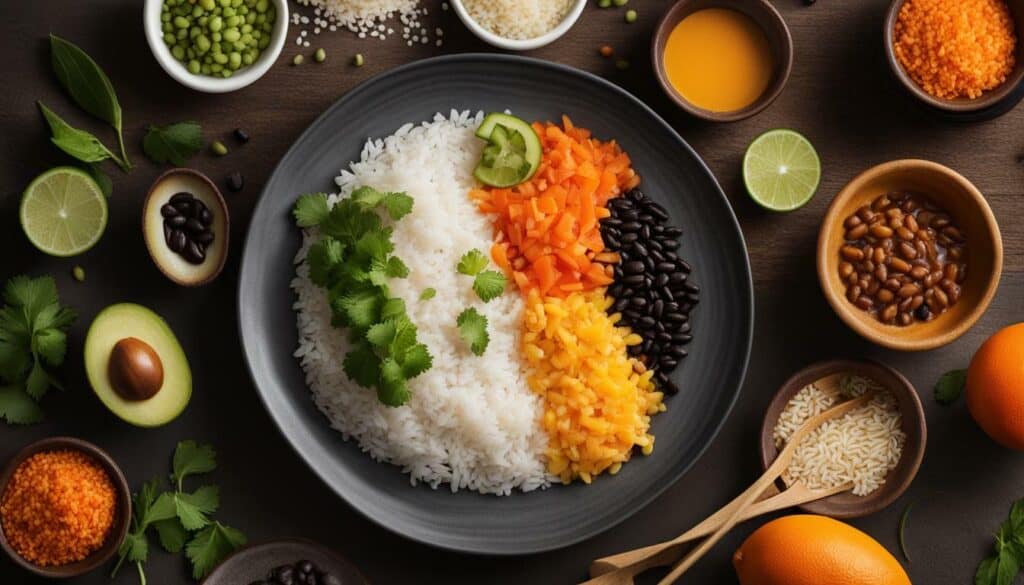
Overall, rice and beans provide a nutritious combination of carbohydrates, protein, fiber, and essential nutrients. By understanding their nutritional value, you can make informed choices about incorporating them into your diet for a healthy and balanced lifestyle.
Rice and Beans: A Balanced Combination
When combined, rice and beans offer a balanced combination of macronutrients and beneficial compounds. Rice, a staple in many cuisines, provides energy through its carbohydrates. However, not all rice is created equal. Opting for brown rice or other whole grain varieties ensures you consume more fiber and essential nutrients. Fiber helps to regulate blood sugar levels and promotes a feeling of fullness, making it an excellent choice for those looking to manage their weight or blood sugar levels.
Beans, on the other hand, are rich in protein, fiber, and antioxidants. They provide sustainable energy and can help stabilize blood sugar levels when paired with rice. The combination of rice and beans creates a complete protein, making it an excellent option for vegetarians or those looking to reduce their meat consumption. The protein in beans helps to build and repair tissues in the body, supporting muscle growth and overall health.
Additionally, beans are packed with essential nutrients such as iron, magnesium, and folate. These nutrients play a crucial role in supporting overall health, including brain function, muscle contraction, and red blood cell production. By incorporating rice and beans into your diet, you can enjoy the benefits of a balanced combination of macronutrients and essential compounds.
| Benefits of Rice and Beans: |
|---|
| 1. Provides sustainable energy |
| 2. Helps regulate blood sugar levels |
| 3. Supports muscle growth and repair |
| 4. Rich in essential nutrients |
“The combination of rice and beans creates a complete protein, making it an excellent option for vegetarians or those looking to reduce their meat consumption.”
How to incorporate rice and beans into your meals
- Add rice and beans to salads for a protein-packed lunch
- Make a flavorful rice and bean stew for a hearty dinner
- Use rice and beans as a filling for burritos or tacos
- Enjoy a traditional rice and beans dish from different cultures
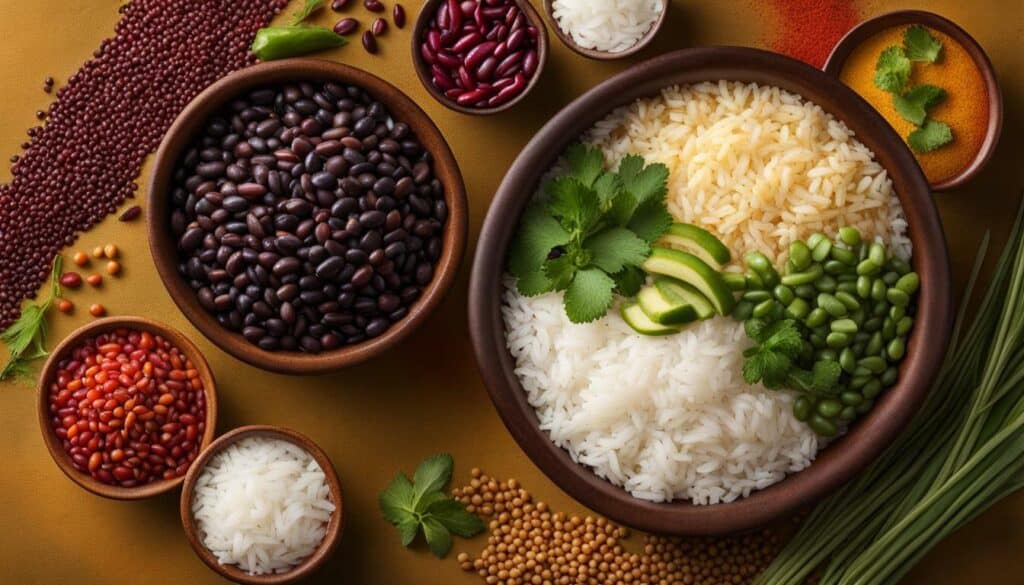
For individuals with type 2 diabetes, incorporating rice and beans into their diet may offer important health advantages. The combination of rice and beans provides a balanced mix of carbohydrates, protein, and fiber, which can help regulate blood sugar levels and support weight loss goals.
Rice, especially white rice, has a high glycemic index, meaning it can cause a rapid increase in blood glucose levels. However, when paired with beans, the glycemic response is reduced. Beans are a complex starch that is high in fiber, which helps slow down the digestion and absorption of carbohydrates. This can prevent unhealthy blood sugar spikes and promote better blood glucose control.
Additionally, the high fiber content of beans can help with weight management. Fiber adds bulk to the diet, promoting feelings of fullness and reducing overall calorie intake. This can be beneficial for individuals with type 2 diabetes who are looking to lose weight or maintain a healthy weight.
| Type | Carbohydrate Content (per 100g) | Fiber Content (per 100g) |
|---|---|---|
| White Rice | 28g | 0.4g |
| Brown Rice | 23g | 1.8g |
| Black Beans | 63g | 16g |
| Pinto Beans | 63g | 15g |
It’s important to note that portion control and overall dietary balance are crucial when incorporating rice and beans into a diabetes-friendly diet. Monitoring serving sizes to manage carbohydrate intake and pairing rice and beans with other nutrient-rich foods, such as vegetables and lean proteins, can help maintain stable blood sugar levels and promote overall health.
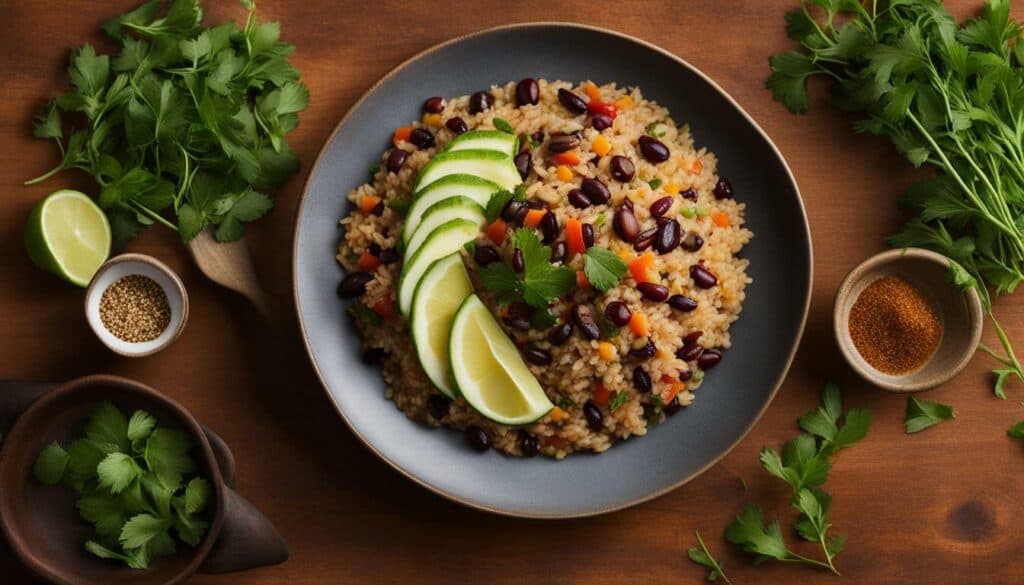
To optimize the nutritional benefits of rice and beans, it’s essential to make informed choices and follow healthy cooking practices. By incorporating these tips into your meal preparation, you can enhance the overall healthiness of this classic combination.
Choose Low Glycemic Index Foods
The glycemic index (GI) measures how quickly a carbohydrate-containing food raises blood sugar levels. Selecting low GI foods can help prevent blood sugar spikes and promote better overall health. Opt for minimally processed whole grain products, such as brown rice and whole wheat bread, which have a lower impact on blood glucose levels. Additionally, beans with a low glycemic index, like black beans, can be a great choice to include in your meals.
Employ Healthy Cooking Techniques
When cooking rice and beans, it’s important to use healthy preparation methods to retain their nutritional value. Avoid deep frying or adding excessive amounts of oil, as this can increase the calorie content of your meal. Instead, try steaming or boiling your rice and beans to preserve their natural flavors and nutrients. You can also experiment with spices and herbs to enhance the taste without relying on salt or unhealthy condiments.
| Healthy Cooking Tips for Rice and Beans |
|---|
| • Steam or boil rice and beans instead of frying |
| • Use herbs and spices instead of excessive salt or unhealthy condiments |
| • Try alternative cooking methods like pressure cooking or slow cooking for added flavor |
| • Rinse canned beans to reduce sodium content |
Incorporate Rice and Beans into a Healthy Diet
While rice and beans can be a nutritious meal option, it’s important to consume a balanced diet that includes a variety of foods. Pairing rice and beans with vegetables or lean proteins like chicken or fish can create a well-rounded meal that provides essential nutrients. Be mindful of portion sizes to maintain a healthy calorie intake and consider incorporating physical activity into your daily routine for optimal health benefits.
To reap the full nutritional rewards of rice and beans, choose low glycemic index foods, employ healthy cooking techniques, and incorporate them into a balanced diet. By making these small adjustments, you can enjoy the delicious flavors of this classic combination while prioritizing your health and well-being.
Cultural Sensitivity and Traditional Foods
Recognizing the cultural significance of rice and beans is essential when discussing their role in dietary recommendations. For many cultures around the world, rice and beans have been a staple food for centuries, providing nourishment and sustenance. This traditional combination not only carries a rich heritage but also offers a range of health benefits.
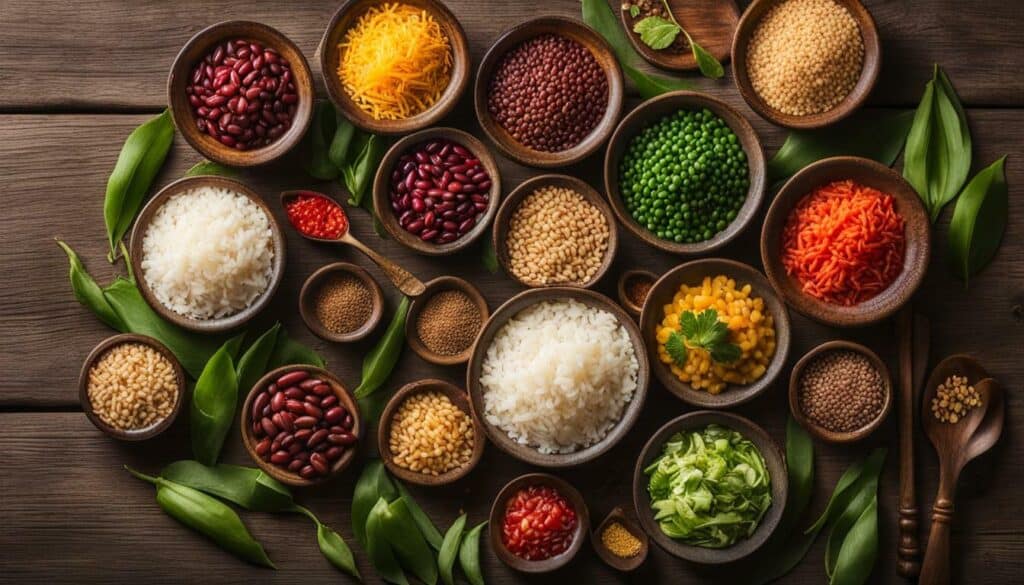
Incorporating traditional foods like rice and beans into dietary guidelines can promote diversity and inclusivity in nutrition recommendations. By embracing cultural sensitivity, we can appreciate the importance of these foods and their place in a balanced diet.
To better understand the impact of traditional foods on health, it is crucial to consider their nutritional value. Rice, for example, is a good source of energy-rich carbohydrates, while beans provide fiber, protein, and essential nutrients. The combination of rice and beans creates a balanced meal that supports satiety and sustained energy levels.
| Traditional Food | Nutritional Benefits |
|---|---|
| Rice | Rich in carbohydrates for energy |
| Beans | High in fiber, protein, and essential nutrients |
Embracing traditional foods like rice and beans can promote both physical and cultural well-being. By celebrating diverse cuisines, we can create dietary recommendations that are both inclusive and healthful.
When incorporating rice and beans into your diet, it’s important to consider portion sizes as well. While these foods offer numerous benefits, consuming them in moderation is key to maintaining a balanced and healthy eating plan.
Summary:
- Rice and beans carry cultural significance and should be considered in dietary recommendations.
- Traditional foods can provide a range of nutritional benefits, including energy, fiber, protein, and essential nutrients.
- Embracing cultural sensitivity when discussing traditional foods promotes inclusivity and appreciation for diverse cuisines.
- Portion control is important to maintain a balanced diet when incorporating rice and beans.
By recognizing the cultural importance of rice and beans and appreciating their role in nutrition, we can foster a more inclusive and diverse approach to dietary recommendations.
The Role of Portion Control
While rice and beans offer numerous health benefits, portion control is key to maintaining a balanced diet. It is easy to overindulge in these delicious foods, but eating them in moderation is crucial for managing calorie intake and ensuring a well-rounded meal.
When it comes to portion sizes, it’s important to strike a balance. A serving of cooked rice is typically recommended to be around 1/2 cup or 1 cup, depending on your calorie needs. Similarly, a serving of cooked beans is usually around 1/2 cup. By following these guidelines, you can enjoy the benefits of rice and beans without consuming excessive calories.
| Food | Portion Size | Calories |
|---|---|---|
| Rice | 1/2 cup | 110 |
| Beans | 1/2 cup | 120 |
Remember to fill the rest of your plate with a variety of vegetables, lean protein, and healthy fats to create a well-rounded meal. By controlling your portion sizes and balancing your plate, you can enjoy the nutritional benefits of rice and beans while maintaining a healthy diet.
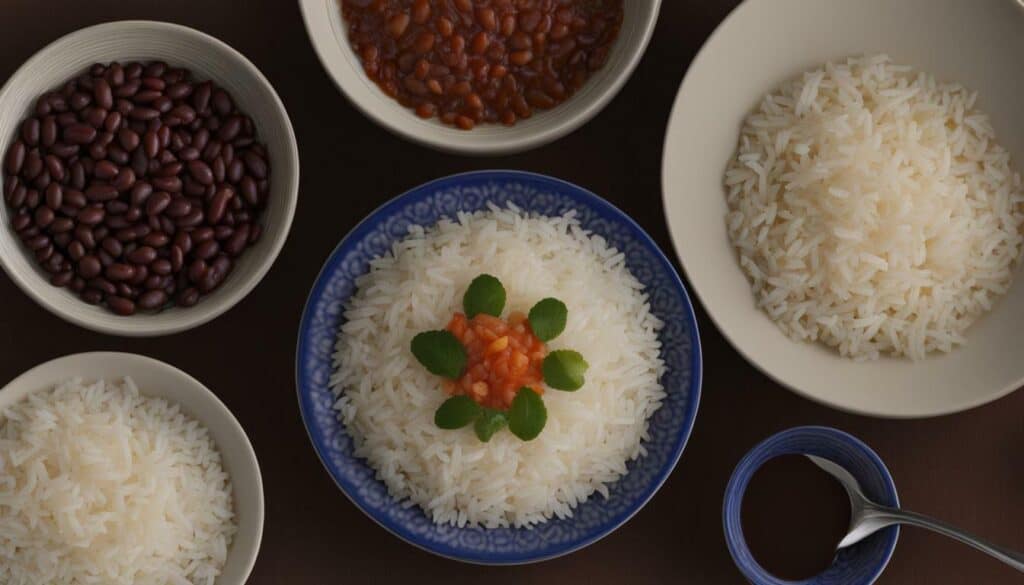
In conclusion, being aware of the carbs in rice and beans and understanding their nutritional information is vital for maintaining a healthy diet. Rice, although it contains fast-digesting carbohydrates, can be balanced out when paired with beans. Beans are a fantastic source of fiber, protein, and essential nutrients. Together, rice and beans provide a complete protein and can help prevent unhealthy blood sugar spikes.
For individuals with type 2 diabetes, the combination of rice and beans can be particularly beneficial in regulating blood sugar levels and supporting weight loss goals. It’s important to note that a variety of foods throughout the day can also provide the necessary protein intake. When considering dietary recommendations, cultural sensitivity plays a crucial role. Traditional foods like beans should be taken into account, as they contribute to diverse and inclusive dietary guidelines.
To make healthier choices, it’s recommended to select carbohydrates with a low glycemic index, such as minimally processed whole grain products, brown rice, whole wheat bread, and beans. These choices can help lower the impact on blood sugar levels and promote long-term health. Additionally, paying attention to portion sizes and limiting the intake of high carbohydrate foods like potatoes is essential for maintaining a balanced diet.
| Carbohydrate Content in Rice and Beans (per 100g) | Rice (cooked) | Beans (cooked) |
|---|---|---|
| Calories | 130 | 120 |
| Total Carbohydrates | 28g | 22g |
| Dietary Fiber | 0.6g | 6.4g |
| Sugars | 0.1g | 0.3g |
| Protein | 2.6g | 7.6g |
Understanding the carbohydrate content and nutritional value of rice and beans allows us to make informed choices that promote overall health and well-being. By incorporating rice and beans into our meals, we can enjoy their delicious flavors while reaping the benefits of a balanced combination that provides sustained energy and supports various health goals.
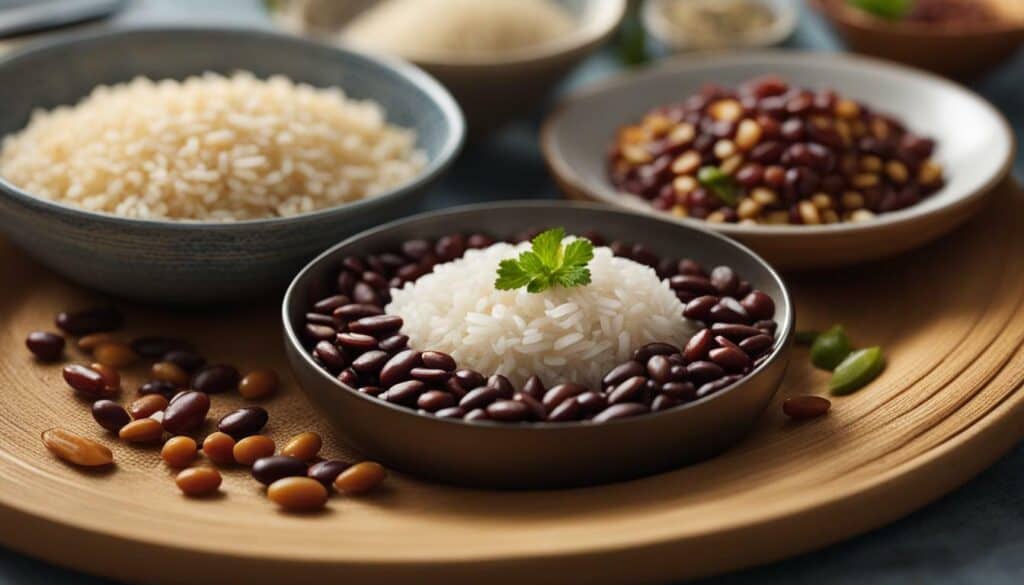
Remember, a healthy diet is not about strict restrictions but rather about making mindful choices that nourish our bodies and bring joy to our meals. So, next time you prepare a plate of rice and beans, savor the knowledge that you are fueling yourself with a nutritious and delicious combination.
Conclusion
In conclusion, being aware of the carbs in rice and beans and understanding their nutritional information is vital for maintaining a healthy diet. White rice, commonly served with beans, contains fast-digesting carbohydrates that can cause blood glucose spikes. However, when paired with beans, the combination helps metabolize the carbs more effectively. Beans, on the other hand, are complex starches that are high in fiber and protein, rich in antioxidants, and contain essential nutrients.
Combining beans with rice not only helps prevent unhealthy blood sugar spikes but also provides a complete protein when consumed together. It’s worth noting that a combination of different foods throughout the day can also achieve the same result. It is crucial to consider cultural sensitivity and include traditional foods like beans in dietary recommendations for diverse populations.
For individuals looking to manage their blood sugar levels and promote long-term health, selecting carbohydrates with a lower impact on blood sugar is essential. This can be achieved by choosing minimally processed whole grain products, brown rice, whole wheat bread, and beans with a low glycemic index. It is also important to limit the intake of potatoes and pay attention to portion sizes to maintain a well-balanced and healthy diet.
FAQ
Q: Are rice and beans high in carbohydrates?
A: Yes, both rice and beans contain carbohydrates. However, the type of carbohydrates and their impact on blood sugar levels differ between the two.
Q: How do rice and beans affect blood glucose levels?
A: White rice, when consumed alone, can lead to spikes in blood glucose levels due to its fast-digesting carbohydrates. However, when paired with beans, the combination helps metabolize the carbs better, preventing unhealthy blood sugar spikes.
Q: What are the nutritional benefits of beans?
A: Beans are complex starches that are high in fiber and protein. They are also packed with antioxidants and contain essential nutrients, making them a healthy addition to any diet.
Q: Can rice and beans be a complete protein source?
A: When eaten together, rice and beans can provide a complete protein. However, incorporating a variety of foods throughout the day can also achieve the same result.
Q: Are there low-carb options for rice and beans?
A: Opting for minimally processed whole grain products like brown rice, whole wheat bread, and beans with a low glycemic index can reduce the impact on blood sugar levels and promote long-term health.
Q: Can rice and beans be part of a healthy diet for people with type 2 diabetes?
A: Yes, the combination of rice and beans can be particularly beneficial for individuals with type 2 diabetes. It helps regulate blood sugar levels and can support weight loss goals.
Q: How can I maximize the nutritional benefits of rice and beans?
A: To maximize the nutritional benefits of rice and beans, choose low glycemic index foods, practice healthy cooking techniques, and pay attention to portion sizes.
Q: Why is cultural sensitivity important when recommending rice and beans?
A: It’s important to be culturally sensitive and consider traditional foods like beans in dietary recommendations for different populations. Traditional foods have a significant cultural significance and should be respected and incorporated into diverse and inclusive dietary guidelines.
Q: Why is portion control important when consuming rice and beans?
A: Portion control plays a key role in maintaining a healthy diet. It is important to pay attention to serving sizes of rice and beans to ensure a balanced and nutritious meal.

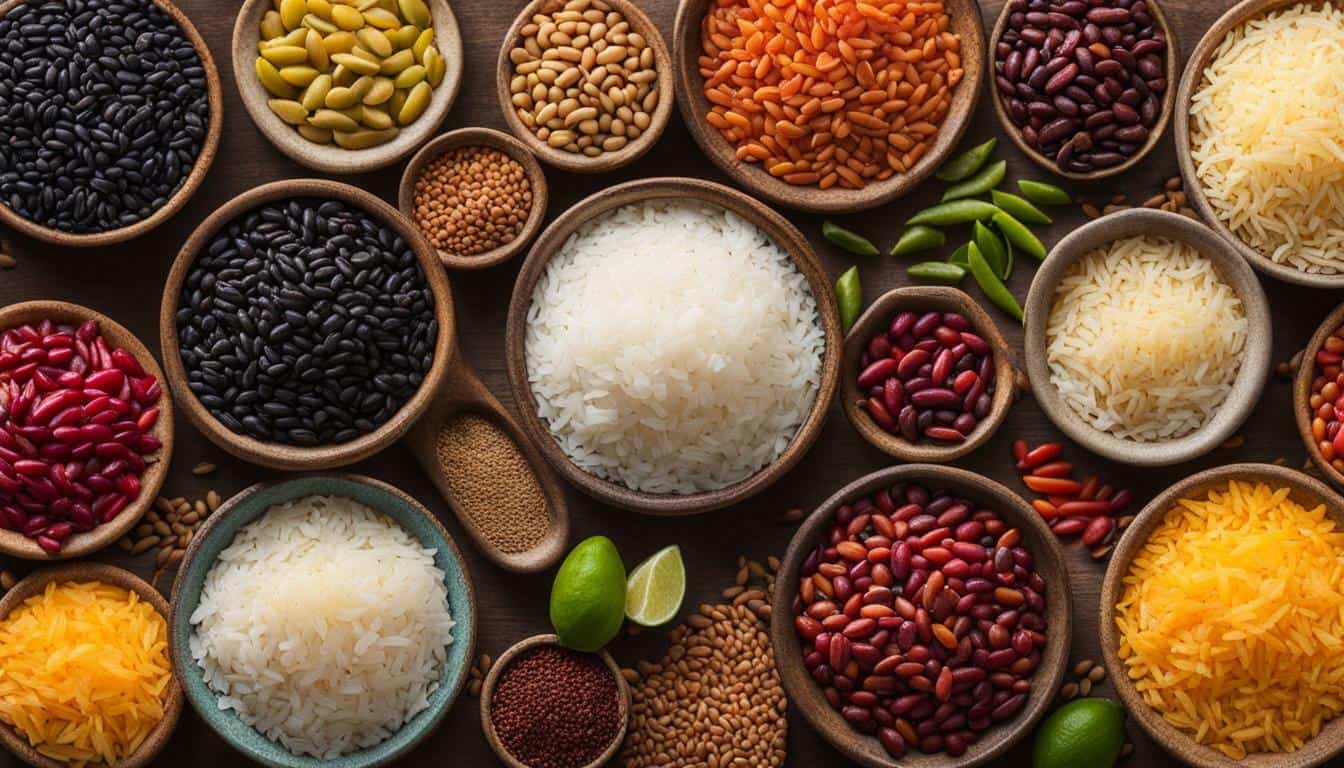



Leave a Reply